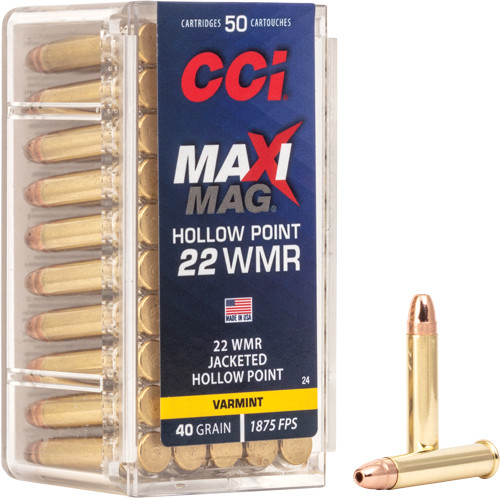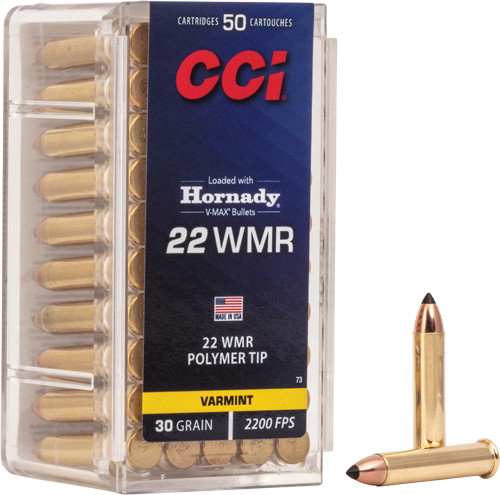.22 WMR Ammo

.22 WMR: In Depth
When it comes to rimfire shooting, most people don’t make it past the super popular, uber cheap, and – by and large – plentiful .22 Long Rifle. There’s simply no arguing with the utility of that cartridge just as it is. However, when some people see rimfire, they might completely rule out any sort of hunting or self defense application, believing (rightly) that .22LR just doesn't have the energy to get the job done on anything but the smallest game. So, what if there was something just a little bit bigger that could reach out with a whole lot more authority?
The truth is, people have been tinkering with rimfire ammunition for a really long time, and this problem was addressed many years ago – sort of. All the way back in 1890, Winchester released a pump-action rifle chambered for the brand new .22 Winchester Rimfire, and not only did this combo have more power than 22LR, but it was all about hunting. .22 WRF was different from .22LR in several ways. Its case was wider and longer, which provided a lot more room for powder, and the heeled bullet of the older cartridge was ditched in favor of a more contemporary design. Velocities were several hundred fps faster, too. The result was heaps more energy on target, at least inside of 75 yards, give or take. All over the US, squirrels, raccoons, foxes, and whatever else happened to be harassing the chickens met their end facing these spicy new .22 caliber rimfire rounds.
Decades later, in the midst of what some folks call the “magnum craze” of the late 50s, Winchester released what was essentially a beefed-up .22 WRF. In choosing to call this creation .22 Winchester Magnum Rimfire, or .22 WMR, they made it awfully similar to the .22 WRF (Winchester Rimfire), leading to much confusion and dismay at the gun counter. Luckily for our sake, the .22 WMR took off and quickly displaced the older .22 WRF, so it's unlikely that anyone will have to tell them apart on a store shelf these days.
Both rifles and revolvers were offered right off the bat, and hunting was the name of the game all around – especially when a rifle could be used to gain the maximum possible velocity. Though it also launched a 40-gr. projectile like its .22LR cousin, .22 WMR had an order of magnitude more power, commonly achieving 1,900/fps at the muzzle. This was plenty of energy for varmints out to 100 yards, or even 125 yards in some cases. Squirrels and racoons beware! In addition, the low recoil and slim case made small revolvers for self defense an appealing carry option for some folks, as some of these guns were extremely light and held seven rounds in the cylinder.
The only downsides – besides the cost of this cartridge compared to .22LR – were realized soon after its introduction: when premium ammo was used in either case, it wasn’t quite as accurate as .22LR, and it had a tendency to damage meat when hunting. Fortunately, this hasn’t been a big deal due to the distances we’re talking about (inside 125 yards), and the fact that people are typically hunting varmints with it, rather than deer or larger game.
Gunmakers were offering semi-auto pistols for this cartridge as early as 1987, but the real renaissance didn’t come until recently. Now, manufacturers like Kel-Tec, S&W, and Walther all produce semi-auto pistols that chamber .22 WMR, mostly with target shooting in mind. Bolt action guns abound for the original mission of pest control or varmint hunting, and Ruger even chambered their Precision Rifle for this round at one time. Plus, it’s small-revolver friendly, so you can carry in a coat pocket without making the leap to a centerfire’s weight and recoil. So, it’s not just a varmint cartridge. Truly, .22 WMR offers about as much versatility as you could possibly expect from a rimfire round.
.22 WMR: Guns
There's an unusually large variety of guns chambered for .22 WMR, given that it’s A) a rimfire cartridge and B) not nearly as popular as .22LR. Since chamber pressures for most .22 rimfire rounds are on the low side (max for both .22LR and .22 WMR is 24,000 psi), actions are relatively cheap to produce; with the exception of the premium semi-auto pistols and revolvers, most .22 WMR guns are pretty affordable. You won’t necessarily see the big selection of replica weapons like you do with .22LR, though. What you will see are a whole lotta bolt guns, rimfire Henrys, full-frame and concealable revolvers, and even some semi-auto rifles and pistols.
Bolt-Action Rifles
- CZ-USA 457 American Bolt Action
- Ruger American Rimfire
- Howa-Legacy M1100
Lever-Action Rifles
- Henry Golden Boy
- Rossi Rio Bravo .22 WMR
- Henry Small Game Octagon
Revolvers
- S&W 351PD
- Ruger LCR
- Taurus Model 942 Ultra-Lite
- S&W Model 48
Semi-Auto Pistols
- Kel-Tec PMR-30
- S&W M&P22 Magnum
- Walther WMP
Semi-Auto Rifles
- Savage A-22
- Kel-Tec CMR-30
- Rossi RS22
Why Choose .22 WMR?
In the first years – maybe even decades – that followed the release of this cartridge, varmint hunting was likely all that you did with a .22 WMR. .22LR has always been far cheaper for target shooting, and defensive use was limited considering what handguns were on offer. However, with the increasing number of semi-auto pistols and concealable revolvers now chambered for .22 WMR, use cases other than hunting are gaining more of a foothold as time goes on. Newer defensive loads feature impressive expansion at low velocities, too.
Hunting
- Pest control and close-range varmint hunting are ideal uses for this cartridge.
- Has a ton more energy than .22LR and is quieter than most centerfire rifle rounds. Your neighbors might appreciate the latter if they live close enough to hear you blasting at squirrels!
Target
- Ammo has always been more expensive than .22LR, but is still cheaper than most other rifle options. It’s generally more reliable than .22LR, as well.
- Walther, S&W, Kel-Tec, and Rock Island all offer / have offered semi-auto pistols that are perfect for fun at the range.
- Reasonably accurate bolt guns are available, though the market is nothing like the precision .22LR market.
Self Defense
- Smith and Wesson’s 351PD and similar lightweight revolvers are highly concealable.
- Ammo makers like Hornady and Speer offer great defensive loads that are optimized for 1 ⅞” barrels (snubnose).
.22 WMR: Ammo Brands and Loadings
Winchester was both the developer and initial manufacturer of this round back in 1959. Since then, CCI, Federal, Remington and many others have all jumped on board, though the current selection is well shy of the comparatively dizzying variety of .22LR loads on offer. On the other hand, .22 Winchester Magnum Rimfire ammo is of much higher quality than .22LR bulk-pack products. Lighter bullets between 25-gr. to 30-gr. are chiefly for hunting, with 40-gr. or 45-gr. loads being most common for universal use. Self defense loads, typically 40-gr. or 45-gr. as well, are often optimized specifically for very the short (1 ⅞”) revolver barrels common to concealable weapons.
Brands
Standard Loading
- 40-gr. JHP @ 1,900/fps
Bullet Types
- JHP (Jacketed Hollow Point) - Hunting, target
- Polymer Tip - Hunting
- FMJ (Full Metal Jacket) - Target
- SP (Lead Soft Point) - Hunting, target
- Shotshell
Bullet Weights
- 25gr. to 30-gr. - Varmint hunting, usually w/ polymer tip
- 40-gr. - Standard weight, all bullet types
- 45-gr. to 50-gr. - Hunting, self defense
Velocities (Rifle)
- 25gr. to 30-gr. - 2,200/fps
- 40-gr. - 1,900/fps
- 45-gr. to 50-gr. - 1,500/fps to 1,700/fps
Velocities (1 ⅞” BBL)
- 40-gr. - 1,050/fps
- 45-gr. to 50-gr. - 1,000/fps
.22 WMR: Frequently Asked Questions
No. These two are not the same, and are not interchangeable. .22 WRF is a much older cartridge with less case capacity and inferior ballistics.
No! This is not safe. Since .22LR is a smaller cartridge than .22 WMR, firing the former in a magnum gun would leave it unsupported by the chamber, leading to case rupture and damage to the gun (and possibly the shooter).
Yes. Although, “pest control” might be a better description than “hunting” when it comes to this round, since it has a reputation for damaging meat. If you’re looking to eat your quarry, .22LR might be a better option. Whatever you can hunt with .22LR, you can also hunt with .22 WMR, but from farther away.
.22 WMR is a step above .22LR in every way, and there are many great pocket revolvers that will conceal effectively under minimal clothing. There are multiple ammo choices on the market that are designed to expand at low velocity and/or penetrate sufficiently when fired from short barrels.
.22 WMR is still a lot less powerful than .38 Special +P, which can also be run in a mini-framed revolver, albeit louder and with more recoil. It’s also rimfire, which comes with its own set of reliability concerns.
Though it definitely has more power than .22LR, this round is pretty anemic for home defense, especially in a handgun. Instead of .22 WMR for this purpose, consider a light-for-caliber (40-gr. to 50-gr.) .223 Remington load, which would start with a lot more energy. Similar to carrying this round concealed: its rimfire, so it may be less reliable compared to a centerfire option.










